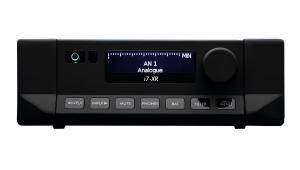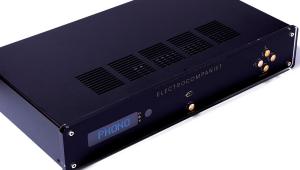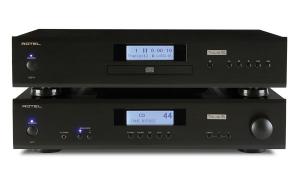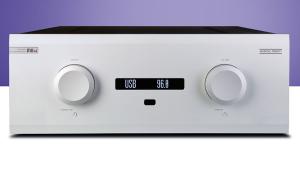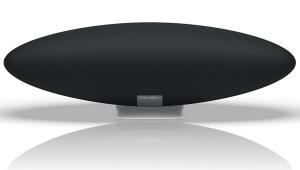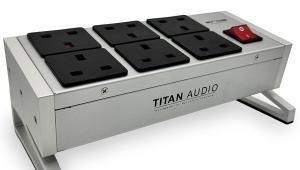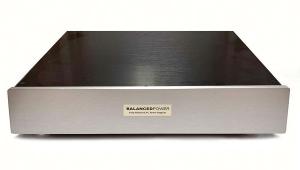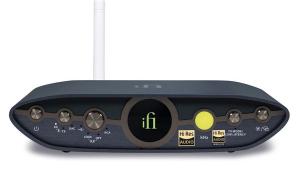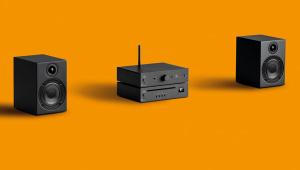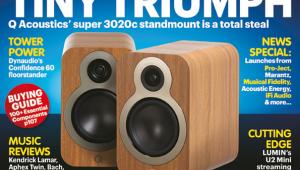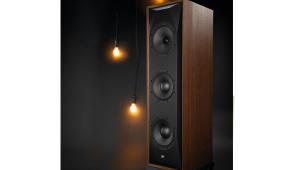Roksan blak

 There’s something very reassuring about a high-end integrated amplifier. While stacks of black boxes might have been the done thing in the early eighties, in today’s world, the trend is to downsize, but music fans don’t want to hear any less of their beloved recordings. The so-called ‘super-integrated’ breed ticks all these boxes; it’s big but not too big, and promises a sound to rival some more expensive pre/power amplifier combinations.
There’s something very reassuring about a high-end integrated amplifier. While stacks of black boxes might have been the done thing in the early eighties, in today’s world, the trend is to downsize, but music fans don’t want to hear any less of their beloved recordings. The so-called ‘super-integrated’ breed ticks all these boxes; it’s big but not too big, and promises a sound to rival some more expensive pre/power amplifier combinations.
Roksan, lest we forget, has always made fine-sounding amplification; it has a distinctly muscular-but-musical character that covers more bases than some rival designs, many of which tend to be one or the other. The blak is a new highish-end integrated that pushes out a claimed 2x 150W RMS, and sports a wide range of inputs to make it flexible enough for today’s brave new hi-fi world. That means two additions to the amps that we were buying a decade ago – aptX Bluetooth and a moving-magnet phono stage. There’s also a USB input connecting to the obligatory DAC.
The blak is a big thing – and heavy too – with a large front-mounted LED display that lights up bright amber. I’m not a fan of the usual blue backlit LCDs, so I love its wilful contrariness, but still you’ve got to wonder if it will go down well with prospective purchasers. The volume control also gets its own light show with a useful indication to show the level. The three fascia-mounted buttons let you scroll through the inputs – totalling three RCA line ins, a pair of analogue XLRs plus the aforementioned USB type-B, aptX Bluetooth and MM phono stage. As per previous Roksan products, the power switch is hidden underneath the fascia on the left, just to confuse you.
The build quality is very good indeed, and while its chunky brushed aluminium fascia looks thick enough to stop a bullet, it doesn’t quite have the immaculate surfacing of some rival Japanese-made products. The pressed steel casework is reassuringly thick and resonance free, and the controls work with a solid – if not exceptionally silky – feel; think Mercedes G-Wagen rather than Lexus RX. The rear panel is equally rugged with good-quality speaker binding posts. Inside, there’s a chunky Noratel toroidal transformer and serious heatsinking for the output devices. A Burr-Brown DSD1794A DAC handles PCM up to 24-bit/192kHz and DSD64 and DSD128, the latter only via the USB socket at the back, which has been properly implemented rather than stuck in as an afterthought. The same can be said of the headphone output, which gets the full might of the power amplifier when it’s switched in via another button hidden underneath, this time in the middle.
Sound quality
Anyone that’s ever heard a Roksan amplifier before will instantly recognise the house sound of the blak. Powerful, punchy, feisty and tough – it’s not the sort of amp that shirks its responsibilities. When asked to drive tricky loudspeakers with powerful dance music like Age Of Love’s Age Of Love, it rises to the challenge gleefully, and supplies a thunderous yet supple and fluid sound that gets the feet tapping.
I find myself transported back to the nineties with this classic trance tune, luxuriating in the blak’s rare combination of sheer brute force and pleasing subtlety. This densely mixed electronic track has a combination of sledgehammer bass and ethereal synthesiser work across the midband. The Roksan catches it beautifully, and tops things off with a sweet treble, letting the hi-hat cymbals glisten like stars in the night sky.
Tonally, the Roksan is sweeter than your average muscle amp – and indeed I’d say this is the brand’s special selling point, it’s ‘naughty but nice’. That self same monster bass is deployed to great effect with the opening Lento Allegro of Ralph Vaughan Williams’ Symphony No.2 (Haitink). It paints a bold, expansive and powerful picture, with a fulsome bottom end and a clean, delicate treble, while the midband remains even and completely devoid of jagged edges. It’s incisive enough to grip the listener, yet never descends into any obvious hardness or grain. Indeed, I’d say the designer has come up with a great balance that sits comfortably across a wide variety of music types. The blak also delivers a quite ‘architectural’ soundstage; all well ordered with everything in its rightful place. It has a fine sense of depth perspective, possibly not quite the best at the price, but still highly convincing. This natural tonality allied to the confident soundstaging makes for a great sense of ‘being there’ in the concert hall.
There’s a sense of seamlessness to the blak too; it avoids the trap of sounding like two different amplifiers at two different volume levels. Blasting The Dukes’ So Much In Love at high levels shows this. A slice of classic jazz funk from 1982, this is immaculately produced and beautifully recorded with some of the best session players in the business. This type of music is less about physical scale, instead the emphasis switching to how well it flows. The blak again proves itself adept at bringing together the music’s rhythmic qualities – capturing the subtle interplay between bass guitar, drums and keyboards – as well as thumping out high levels. Notching the volume down a peg or three, it continues to sound fluid and musical, with a subtly sweet tonality. Its fundamentally well balanced nature makes for an inviting and lustrous sound, that really works for the music.
Born to rock
Another challenge is good old unreconstructed rock music, so I cue up REM’s Maps And Legends from Fables Of The Reconstruction. This is a great album, but it was recorded in a cheap London studio back in the early eighties and sounds rather dirge like. Still, the Roskan proves well able to scythe through and bring the music out brilliantly. The beautiful Rickenbacker guitar work and Byrds-like vocal harmonies are carried delicately, the music flowing freely yet punching its way around my listening room with genuine authority. The Roksan’s midband is commendably neutral and carries singer Michael Stipe’s plaintive vocals very well, too. The amp tracks the song’s dynamics adeptly, never sounding breathless or falling to pieces on crescendos and gives a highly natural sound. Again, this type of music really benefits from the amplifier’s vast, cathedral-like soundstage going from left to right, and the sheer confidence with which it drives even tricky speaker loads.
The Bluetooth connectivity will be a boon for some, and an irrelevance to others. Personally I like it; sonically it’s not a patch on the line inputs, or indeed the DAC running standard digital, let alone hi-res. But the convenience shines through; it’s easy to hook up and stable – and you can zip through your favourite tunes on your phone or iPad while doing the ironing. Even when you sit down for a serious listen, it sounds pleasingly warm and uninvasive. Hook up your laptop to its USB input, however, and there’s a step change for the better. I run the gamut of my ever-expanding hi-res file collection and enjoy the crisp, clean sound across a wide range of music and file types. I particularly love its very subtle and involving, yet strong and beautifully proportioned rendering of Wings’ Band On The Run at 24/96. It captures the album’s characteristically dry sound beautifully yet is never boring – and has the dynamic headroom to fully exploit the lack of compression on the hi-res version of this classic track.
The built-in DAC implementation is better than the ‘merely competent’ I had expected. It means the amplifier is quite listenable if digital is your sole source and you don’t wish to buy an external DAC – aside from the fact that there’s only one digital input, of course. You can do better, but you’ll need to spend around £1,000 to really improve on what the blak comes fitted with. It’s also worth pointing out that the Roksan has a superb headphone sound, for those of you with a decent pair of cans, and/or neighbours who rather selfishly don’t share your taste for Scandinavian death metal at three o’clock in the morning. Indeed, that’s the great thing about this amplifier, it has a good range of facilities that offer high-quality listening in several contexts, not just the conventional line input and speakers configuration. Sonically, the only criticism is that ‘it is what it is’, which is to say a powerful solid-state amp.
Conclusion
Another redoubtable new product from Roksan, then. The blak will hit the spot for those wanting a good value for money, high-powered and musically satisfying integrated amplifier – one that delivers the sort of punch that you’d normally need to turn to pre-power amplifier combinations to find. Factor in its wide and handy selection of inputs, and the well put together single-box design, and it’s an impressive package. Some may think it a bit quirky to use, but others will see it as a charm – certainly, it is never a dull listening companion. DP
DETAILS
PRODUCT: Roksan blak
PRICE: £2,750
ORIGIN: UK
TYPE: Integrated amplifier with DSD-capable DAC
WEIGHT: 13kg
DIMENSIONS: (WxHxD) 440 x 140 x 305mm
FEATURES
● Quoted power: 150W RMS (8ohm)
● Inputs: 1x MM phono; 3x RCA line; 1x balanced XLR; 1x USB
● AptX Bluetooth
DISTRIBUTOR: Henley Designs Ltd.
TELEPHONE: 01235 511166
WEBSITE: henleydesigns.co.uk; roksan.co.uk
 Read the full review here
Read the full review here
 |
Inside this month's issue:
Ruark R610 music system and Sabre-R standmount speakers, PMC twenty.23i Active, floorstanders, English Acoustics Downton preamplifier, Bluesound NODE ICON preamp/streamer, Ortofon Concorde Music Blue MM cartridge and much, much more
|






